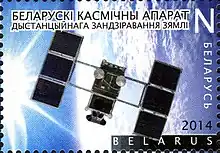| Mission type | Earth observation |
|---|---|
| Operator | National Academy of Sciences of Belarus |
| Mission duration | 5 years (planned) Failed to orbit |
| Spacecraft properties | |
| Launch mass | ~750 kilograms (1,650 lb) |
| Start of mission | |
| Launch date | July 26, 2006 |
| Rocket | Dnepr |
| Launch site | Baikonur 109/95 |
| Orbital parameters | |
| Reference system | Geocentric |
| Regime | Low Earth Orbit |
| Perigee altitude | 510 kilometres (320 mi) |
| Apogee altitude | 510 kilometres (320 mi) |
| Epoch | Planned |
BelKA or BKA (an acronym from Belarusian: Беларускі Касмічны Апарат, Belarusian Cosmic Apparatus) is the first satellite of independent Belarus.
First attempt
It was a remote sensing satellite that utilizes the USP (satellite bus), developed by Belarusian researchers and Russian Rocket and Space Corporation RSC Energia for National Academy of Sciences of the Republic of Belarus as the final customer of the satellite, which had the capacity to take photos of the Earth surface, with a maximum resolution of 2-2.5 meters.
BelKA was launched, along with seventeen other satellites, on July 26, 2006 at 19:43 GMT, however 86 seconds later, the Dnepr rocket suffered an engine failure and crashed, destroying the satellites.[1]
The name BelKA is thought to be an allusion to the Soviet space dog, Belka, who, together with Strelka orbited the Earth and returned safely on Sputnik 5 in 1960.
- Configuration: Victoria bus
- Outcome: Carrier rocket failure, satellite destroyed
Second attempt

The second launch (BKA) was successful. It was launched together with the Russian satellite Canopus-B from the Baikonur Cosmodrome on July 22, 2012, after a long delay. Belarus put the plame for the delay onto British software.[2][3] It was planned to be operational until the end of 2021.[4]
References
- ↑ "Russian rocket crashes after launch". MSNBC. 2006-07-26. Archived from the original on 2006-08-21. Retrieved 2006-07-27.
- ↑ Запуск белорусского и российского спутников переносился из-за недоработки программного обеспечения
- ↑ Первая информация со спутника поступила в белорусский ЦУП
- ↑ Беларусь и космос: глава Академии наук о новом спутнике, экспериментах и технологиях